| DC28434 |
PCS1055 dihydrochloride |
PCS1055 dihydrochloride is a potent, selective and competitive muscarinic M4 receptor antagonist with an IC50 of 18.1 nM and a Kd of 5.72 nM. PCS1055 dihydrochloride inhibits radioligand [3H]-NMS binding to the M4 receptor with a Ki of 6.5 nM. PCS1055 dihydrochloride exhibits >100-fold selectivity over M1-, M3-, and M5-receptors and 30-fold selectivity at the M2 receptor. PCS1055 dihydrochloride is also a potent AChE inhibitor with IC50 s of 22 nM and 120 nM for electric eel and human AChE, respectively. |

|
| DC28809 |
Solifenacin D5 hydrochloride |
Solifenacin D5 hydrochloride is a deuterium labeled Solifenacin hydrochloride. Solifenacin hydrochloride is a muscarinic receptor antagonist with pKis of 7.6, 6.9 and 8.0 for M1, M2 and M3 receptors, respectively. |

|
| DC28989 |
Terodiline hydrochloride |
Terodiline hydrochloride is an M1-selective muscarinic receptor (mAChR) antagonist with Kbs of 15, 160, 280, and 198 nM in rabbit vas deferens (M1), atria (M2), bladder (M3) and ileal muscle (M3), respectively. Terodiline hydrochloride also is a Ca2+ blocker. Terodiline hydrochloride acts as a treatment for urinary frequency and urge incontinence. |

|
| DC29053 |
(R,R)-Glycopyrrolate |
(R,R)-Glycopyrrolate ((R,R)-Glycopyrronium (bromide); (R,R)-Glycopyrrolate (bromide)) is an anticholinergic agent. (R,R)-Glycopyrrolate ((R,R)-Glycopyrronium (bromide); (R,R)-Glycopyrrolate (bromide)) has the ability to reduce the frequency of drooling in vivo with developmental disabilities. |

|
| DC40216 |
VU0119498
Featured
|
VU0119498 is a pan Gq mAChR M1, M3, M5 positive allosteric modulator (PAM), with EC50s of 6.04, 6.38, and 4.08 μM, respectively. VU0119498 has antidiabetic activity. |

|
| DC40289 |
VU0238441
Featured
|
VU0238441 is a pan muscarinic acetylcholine receptor (mAChR) positive allosteric modulator (PAM) with EC50s of 3.2 μM, 2.8 μM, 2.2 μM, 2.1 μM, >10 μM for M1, M2, M3, M5 and M4, respectively. |

|
| DC41142 |
Nor-benzetimide
Featured
|
Nor-benzetimide is a major metabolite of Benzetimide. Benzetimide is a mAChR antagonist with anticholinergic activity. |
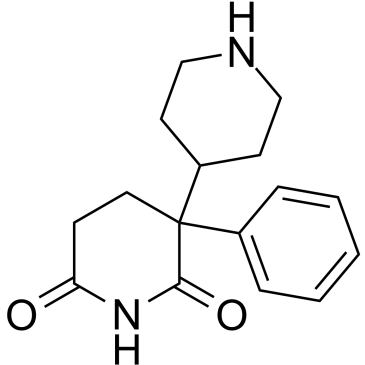
|
| DC41213 |
Clidinium-D5 bromide |
Clidinium-D5 bromide (Ro 2-3773-D5) is the deuterium labeled Clidinium bromide. Clidinium bromide is a quaternary amine antimuscarinic agent. |

|
| DC41236 |
Telenzepine dihydrochloride |
Telenzepine dihydrochloride is a selective and orally active muscarinic M1 receptor antagonist with a Ki of 0.94 nM. Telenzepine dihydrochloride inhibits gastric acid secretion and has antiulcer effects. |

|
| DC41296 |
Anisodamine hydrobromide |
Anisodamine hydrobromide (6-Hydroxyhyoscyamine hydrobromide), a belladonna alkaloid, is a non-subtype-selective muscarinic and a nicotinic cholinoceptor antagonist. Anisodamine hydrobromide shows antioxidant, anti-inflammatory properties. |

|
| DC41809 |
[D-Trp7,9,10]-Substance P |
[D-Trp7,9,10]-Substance P is the substance P analog that inhibits activation of Gq/11 by M1 muscarinic ACh receptors. [D-Trp7,9,10]-Substance P does not inhibit Gi/o activation by M2 ACh receptors. |

|
| DC41810 |
[D-Trp7,9,10]-Substance P TFA |
[D-Trp7,9,10]-Substance P TFA is the substance P analog that inhibits activation of Gq/11 by M1 muscarinic ACh receptors. [D-Trp7,9,10]-Substance P TFA does not inhibit Gi/o activation by M2 ACh receptors. |

|
| DC41811 |
G-Protein antagonist peptide |
G-Protein antagonist peptide is the substance P-related peptide that inhibits binding of G proteins to their receptors. G-Protein antagonist peptide competitively and reversibly inhibits M2 muscarinic receptor activation of Gi or Go and inhibits Gs activation by β-adrenoceptors. |

|
| DC41812 |
G-Protein antagonist peptide TFA |
G-Protein antagonist peptide TFA is the substance P-related peptide that inhibits binding of G proteins to their receptors. G-Protein antagonist peptide TFA competitively and reversibly inhibits M2 muscarinic receptor activation of Gi or Go and inhibits Gs activation by β-adrenoceptors. |

|
| DC44703 |
Ipratropium bromide monohydrate |
Ipratropium bromide (Atrovent, Sch 1000) monohydrate is an antagonist of muscarinic acetylcholine receptors (mAChR) with IC50 of 2.9 nM, 2.0 nM, and 1.7 nM for M1, M2, and M3 receptors, respectively. |

|
| DC44944 |
JHU37160
Featured
|
JHU37160 is a potent and brain-penetrant DREADD agonist, with EC50s of 18.5 nM and 0.2 nM for hM3Dq and hM4Di DREADDs in HEK-293 cells, respectively. JHU37160 exhibits selective [3H]Clozapine displacement from DREADDs and not from other Clozapine-binding sites in mice brain tissue. |

|
| DC44945 |
JHU37152
Featured
|
JHU37152 is a Designer Receptors Exclusively Activated by Designer Drug (DREADD) agonist with Ki of 1.8 nM and 8.7 nM for human muscarinic acetylcholine M3 receptors (hM3Dq) and hM4Di in vitro, respectively. And EC50 values are 5 nM and 0.5 nM for hM3Dq and hM4Di in fluorescent and BRET-based assays in HEK-293 cells, respectively.,hM4Di [1](Cell-free assay)
hM3Dq [1](Cell-free assay)
hM3Dq [1](Cell-free assay)
hM4Di [1](Cell-free assay)
0.5 nM(EC50)
1.8 nM(Ki)
5 nM(EC50)
8.7 nM(Ki),JHU37152 is a potent DREADD agonist with high potency and efficacy in fluorescent and BRET-based assays in HEK-293 cells, whereas no responses are observed in untransfected HEK-293 cells.[1],JHU37152 exhibits high in vivo DREADD potency. JHU37152 exhibits selective [3H]clozapine displacement from DREADDs in brain tissue from WT and D1-DREADD mice.[1] |
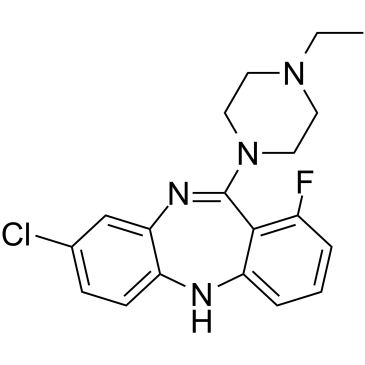
|
| DC45324 |
Sofpironium bromide
Featured
|
Sofpironium bromide (BBI 4000) is an anticholinergic agent used in the study of primary axillary hyperhidrosis (PAH). Sofpironium bromide reduces sweating by inhibiting M3 muscarinic receptors in eccrine glands at the application site. Sofpironium bromide also has a high afnity for the M1, M2, M4 and M5 subtypes. |
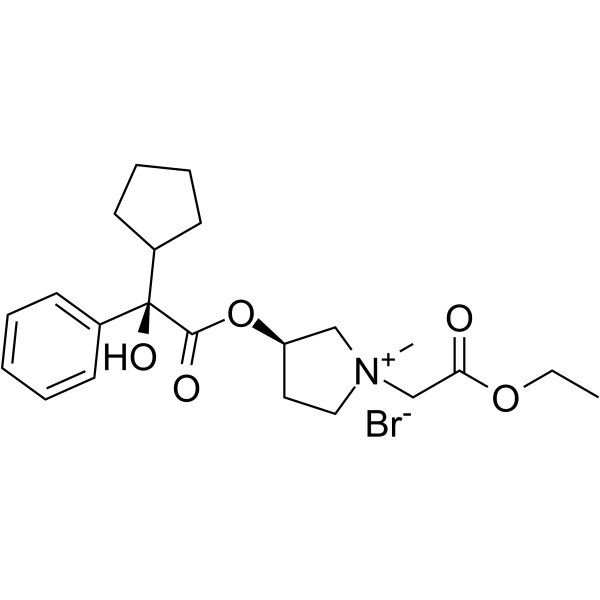
|
| DC45404 |
Guvacoline hydrochloride |
Guvacoline hydrochloride, a pyridine alkaloid found in Areca triandra, can act as a weak full agonist of atrial and ileal muscarinic receptors. |

|
| DC45571 |
VU6000918 |
VU6000918 is a muscarinic acetylcholine (M4) positive allosteric modulator, with an EC50 of 19 nM for hM4. |

|
| DC45777 |
Xanomeline |
Xanomeline, as an effective and selective muscarinic type 1 and type 4 (M1/M4) receptor agonist, increases neuronal excitability. Xanomeline can be used for the research of neurological disorders, such as schizophrenia. |

|
| DC46288 |
Dronedarone D6 hydrochloride |
Dronedarone D6 hydrochloride is the deuterium labeled Dronedarone. Dronedarone hydrochloride, a derivative of Amiodarone, is a class III antiarrhythmic agent for the study of atrial fibrillation (AF) and atrial flutter. Dronedarone hydrochloride is a potent blocker of multiple ion currents, including potassium current, sodium current, and L-type calcium current, and exhibits antiadrenergic effects by noncompetitive binding to β-adrenergic receptors. Dronedarone hydrochloride is a substrate for and a moderate inhibitor of CYP3A4.
|

|
| DC46290 |
Muscarine iodide |
Muscarine ((+)-Muscarine) iodide is a toxin that can stimulate the parasympathetic nervous system. Muscarine iodide is a prototype muscarinic acetylcholine receptor agonist. |

|
| DC46423 |
W-84 dibromide |
W-84 (dibromide) is a potent allosteric modulator of M2-cholinoceptors, which retards [3H]N-methylscopolamine dissociation. W-84 dibromide can stabilize cholinergic antagonist-receptor complexes. W-84 (dibromide) is a non-competitive muscarinic acetylcholine receptors antagonist with allosteric effects. W-84 (dibromide) protects over additively against an organophosphate-intoxication when applied in combination with atropine. |

|
| DC46843 |
(S)-(+)-Dimethindene maleate |
(S)-(+)-Dimethindene maleate, an enantiomer, is a potent M2-selective muscarinic receptor antagonist (pA2 = 7.86/7.74; pKi = 7.78). (S)-(+)-Dimethindene maleate shows lower affinities for the muscarinic M1 (pA2 = 6.83/6.36; pKi = 7.08), the M3 (pA2 = 6.92/6.96; pKi = 6.70) and the M4 receptors (pKi = 7.00), respectively. (S)-(+)-Dimethindene maleate also is a histamine H1 receptor antagonist (pA2 = 7.8). |

|
| DC46844 |
Emraclidine
Featured
|
Emraclidine is a muscarinic M4 receptor positive allosteric modulator (WO2018002760, compound 11). Emraclidine can be used for the research of neurological diseases. |
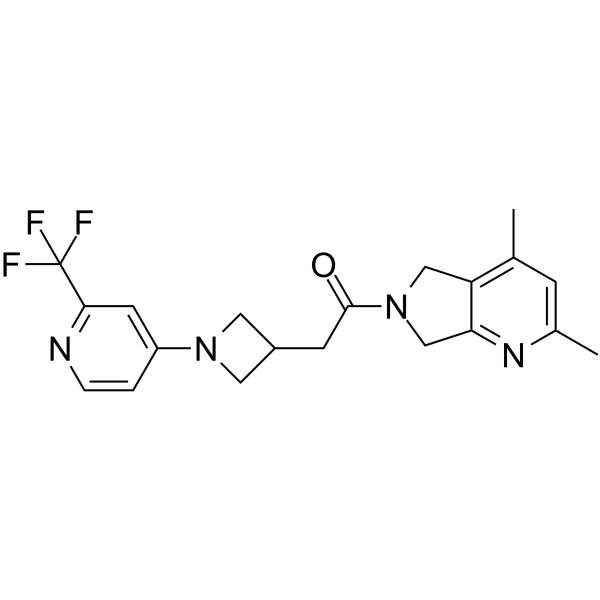
|
| DC47080 |
Velufenacin
Featured
|
Velufenacin is a muscarinic receptor antagonist. |
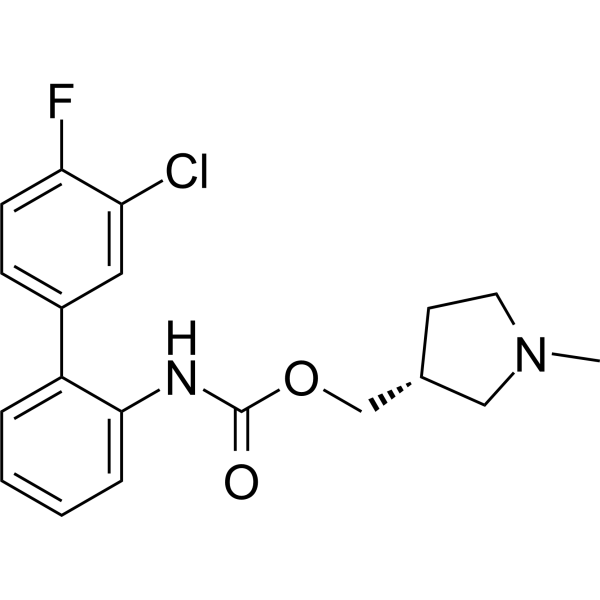
|
| DC47097 |
Navafenterol saccharinate |
Navafenterol (AZD-8871) saccharinate is an inhaled, long-acting bronchodilator, which is a muscarinic antagonist and β2 agonist. |

|
| DC47237 |
PD 102807
Featured
|
PD 102807 is a M4 muscarinic receptor antagonist with an IC50 of 90.7 nM. PD 102807 inhibits M1, M2, M3, M5 muscarinic receptor with IC50s of 6558.7, 3440.7, 950.0, and 7411.7 nM, respectively. Antidyskinetic effect. |
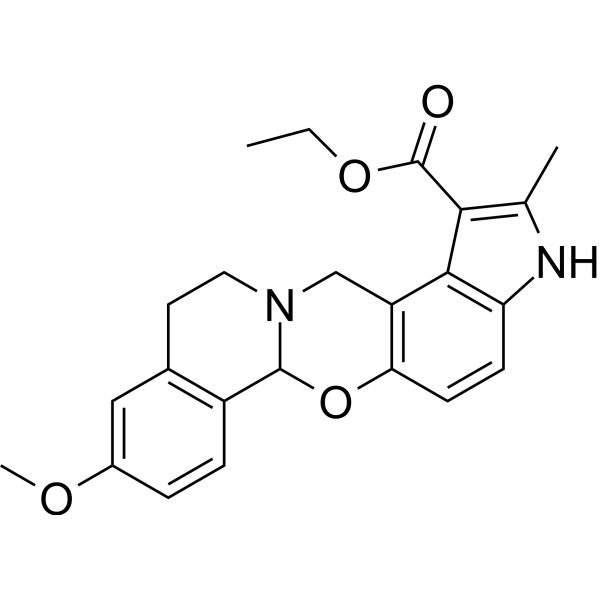
|
| DC47578 |
(Rac)-5-Hydroxymethyl Tolterodine |
(Rac)-5-Hydroxymethyl Tolterodine ((Rac)-Desfesoterodine), an active metabolite of Tolterodine, is a mAChR antagonist (Ki values of 2.3 nM, 2 nM, 2.5 nM, 2.8 nM, and 2.9 nM for M1, M2, M3, M4, and M5 receptors, respectively). (Rac)-5-Hydroxymethyl Tolterodine can be used for overactive bladder research. |

|





























